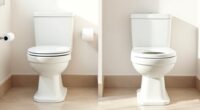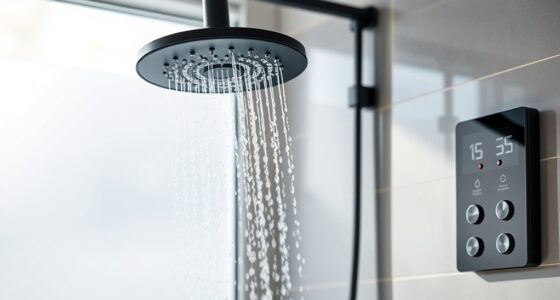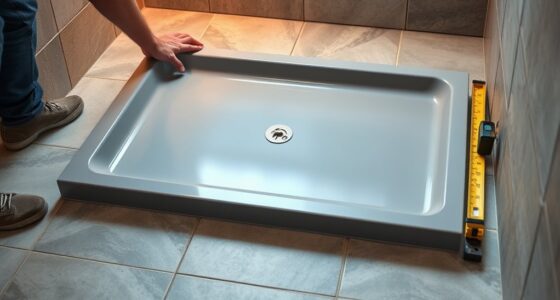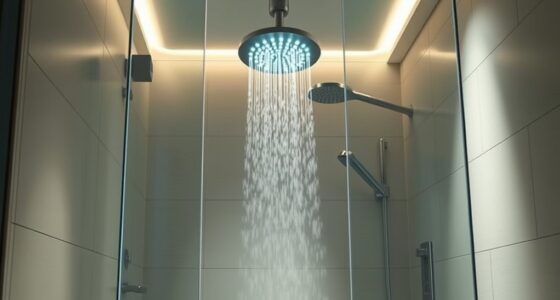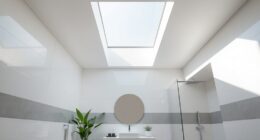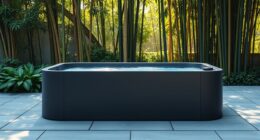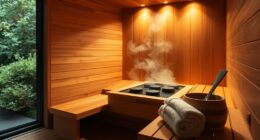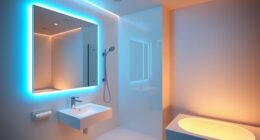To design a safe and stylish curbless shower, choose a spacious layout with seamless tile patterns and proper slope toward the drain. Use durable, waterproof materials like porcelain or ceramic tiles, and install waterproof membranes beneath surfaces to prevent leaks. Incorporate slip-resistant surfaces and grab bars for safety, and work with experienced professionals to guarantee correct waterproofing and drainage. Continuing will help you uncover essential tips for a flawless, long-lasting installation.
Key Takeaways
- Ensure a seamless, barrier-free entry with low or zero-threshold designs for easy access and safety.
- Use large-format, non-porous tiles with minimal grout to simplify cleaning and prevent mold buildup.
- Incorporate proper waterproofing membranes and a consistent slope toward the drain to prevent water pooling.
- Select slip-resistant tiles or coatings to enhance safety in open, barrier-free shower spaces.
- Collaborate with experienced professionals to ensure correct installation of waterproofing and drainage systems.
Choosing the Right Location and Layout for Your Curbless Shower
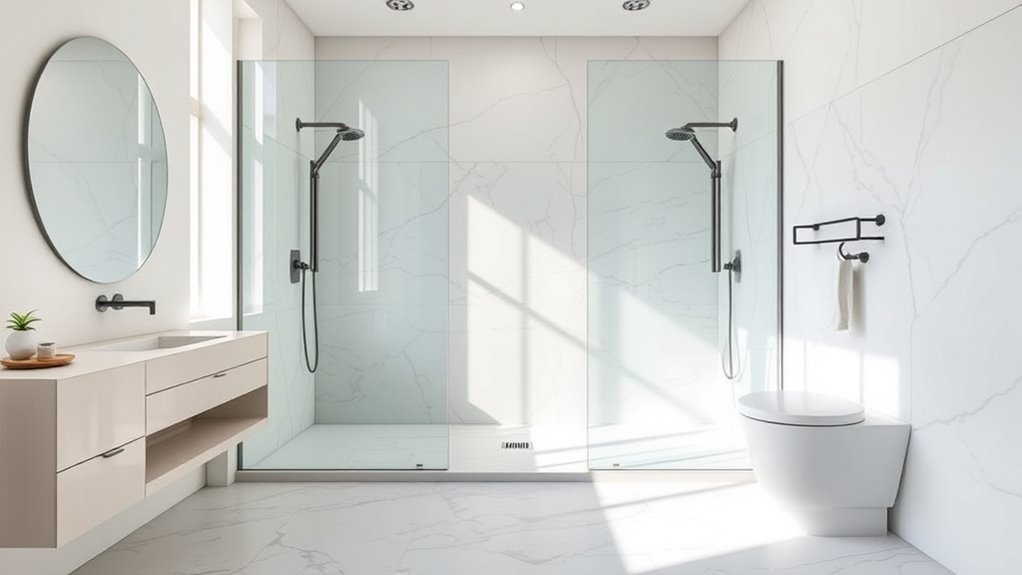
Selecting the right location and layout for your curbless shower is essential to guarantee both functionality and aesthetics. You want to choose an area with enough space that allows for a seamless, barrier-free entry. Consider how tile patterns will flow across the floor and walls—aligning tiles can enhance the visual appeal and make the space appear larger. Proper lighting placement is also key; position lights to highlight key features like tile patterns and ensure the shower feels bright and inviting. Avoid cramped corners or obstructed pathways, as these can compromise accessibility and safety. By carefully planning the layout, you’ll create a shower that’s not only stylish but also easy to use and maintain, making it a standout feature in your bathroom.
Selecting Durable and Waterproof Materials for Seamless Design

Choosing the right materials is essential to guarantee your curbless shower remains both beautiful and functional over time. Your material selection should focus on durability and waterproofing techniques to prevent leaks and damage. Opt for slip-resistant tiles and waterproof membranes that can withstand moisture exposure. Consider high-quality porcelain or ceramic tiles, as they’re both durable and easy to clean. Using a waterproofing membrane beneath the surface layer creates a seamless barrier against water infiltration. Proper installation methods, such as correct membrane application, are crucial to ensure long-lasting results. Additionally, selecting waterproofing techniques that are compatible with your chosen materials can further enhance the shower’s resistance to water damage. Incorporating proper installation techniques is vital to maximize the effectiveness of your waterproofing solutions.
A thorough understanding of waterproofing systems can help prevent costly repairs and ensure your shower remains leak-free for years.
Ensuring Proper Slope and Drainage for Safety and Functionality
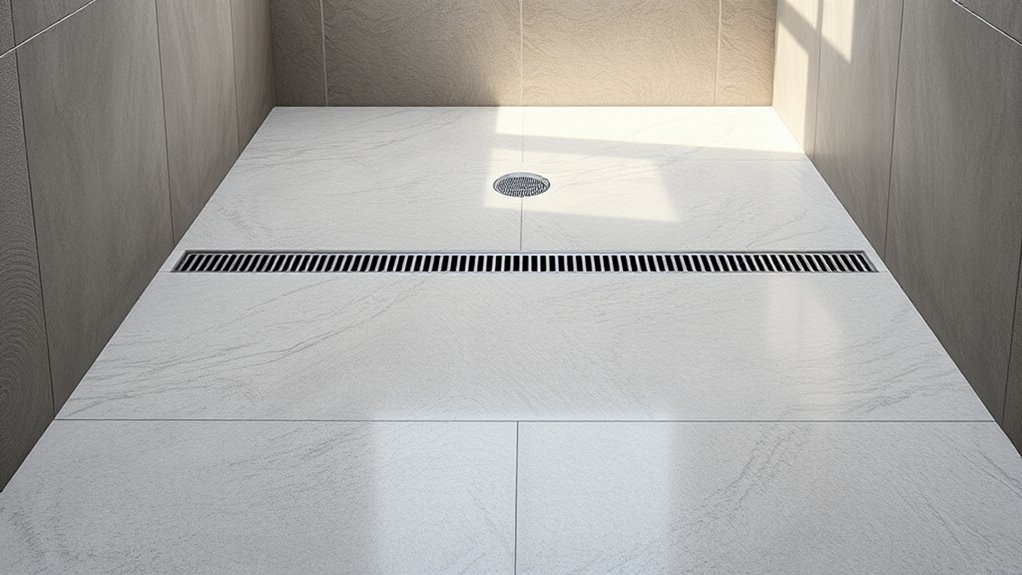
To keep your curbless shower safe and functional, you need to get the slope just right. Following ideal slope guidelines ensures water flows smoothly to the drain without pooling. Effective drainage strategies help prevent slips and water damage, making your shower both practical and secure. Using the correct floor slope can significantly improve water drainage and overall safety.
Optimal Slope Guidelines
Ensuring the proper slope in a curbless shower is essential for effective drainage and safety. Typically, a slope of about 1/4 inch per foot directs water toward the drain, preventing pooling. When planning tile patterns, consider how the slope interacts with your design; a consistent slope helps keep the surface smooth and safe. Proper lighting options can highlight the slope subtly, ensuring you see the floor’s incline without harsh glare. Use your tile layout to reinforce the slope’s direction, making sure it’s gentle enough for comfortable walking while still guiding water efficiently. Avoid sharp angles that disrupt flow, and double-check that the slope remains uniform across the entire shower area. This careful attention helps create a safe, functional, and visually appealing curbless shower. Incorporating innovative materials can further enhance drainage performance and durability over time.
Effective Drainage Strategies
Proper drainage in a curbless shower hinges on implementing an effective slope that directs water toward the drain and prevents pooling. Your drainage system must be carefully designed to guarantee proper water flow, avoiding water buildup that can cause slipping hazards or water damage. Use a consistent slope of about 1/4 inch per foot to guide water efficiently. Consider installing a linear drain for a seamless look and even water distribution. Ensuring the substrate is properly sloped and using appropriate waterproofing techniques will help maintain ideal water flow. Regularly check the drain and slope during installation to prevent future issues. Additionally, researching drainage system management can provide insights into optimizing water flow and preventing potential problems. Understanding pore size and how glycolic acid affects it will also help in planning effective drainage and maintenance strategies. By prioritizing these drainage strategies, you’ll create a safe, functional, and visually appealing curbless shower.
Incorporating Non-Slip Surfaces for Enhanced Safety

Adding non-slip surfaces to your curbless shower is essential for safety, especially since the open design reduces barriers and increases the risk of slips. You should prioritize slip resistance when selecting safety flooring, ensuring it provides reliable traction even when wet. Textured tiles, such as those with a matte or honed finish, help prevent accidents by offering better grip. Consider installing slip-resistant coatings or treatments on smooth surfaces for added security. Using safety flooring with built-in slip resistance features can markedly reduce the chance of falls. Remember, the goal is to create a safe, accessible environment without compromising style. Incorporating these elements not only enhances safety but also boosts confidence in using your beautiful, open-concept shower. Performance Cookies tracking can help monitor how well your safety measures are working over time. Additionally, choosing textured surfaces designed specifically for wet environments can further improve slip resistance and overall safety.
Planning for Adequate Waterproofing and Moisture Barriers
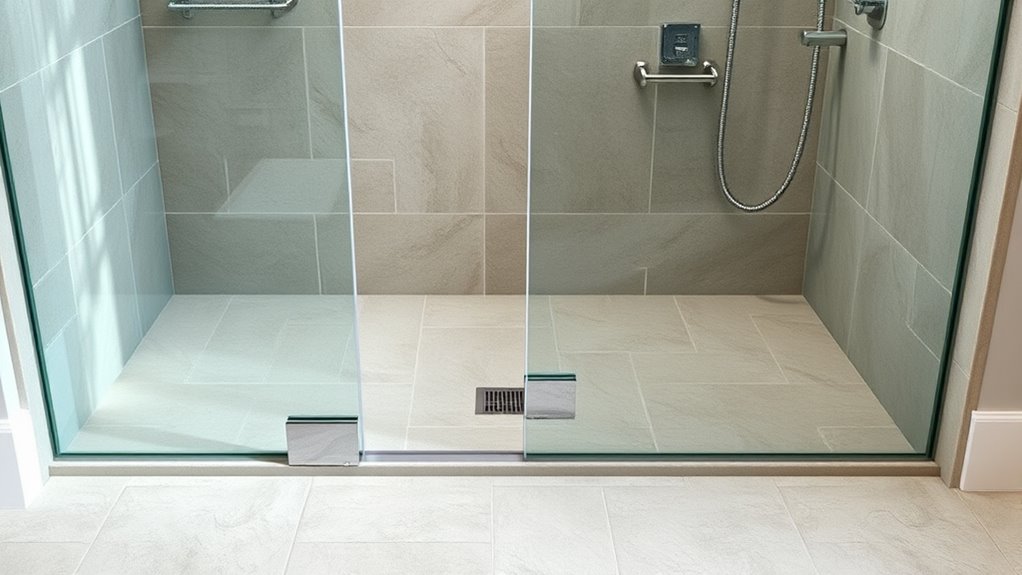
Since water constantly interacts with the shower enclosure, planning for adequate waterproofing and moisture barriers is essential to prevent leaks and damage. You need to select high-quality waterproofing membranes that effectively seal all joints, corners, and seams. These membranes act as a reliable moisture barrier, stopping water from seeping into surrounding structures. Install these barriers beneath the tile and around the shower’s perimeter, ensuring full coverage. Proper placement and sealing of the waterproofing system will protect your subfloor and walls from water damage over time. Incorporating sound scientific principles into your waterproofing approach can enhance the effectiveness of your moisture protection. Using appropriate sealing techniques ensures long-term durability and leak prevention. Additionally, choosing membranes with industry-recognized durability helps guarantee your shower remains leak-proof for years to come. Employing effective waterproofing methods based on proven research can further improve your shower’s resistance to water infiltration. Investing in quality waterproofing membranes now is a key step in preventing water damage, which saves you headaches later and guarantees a durable, leak-proof curbless shower.
Integrating Accessibility Features for Inclusive Use
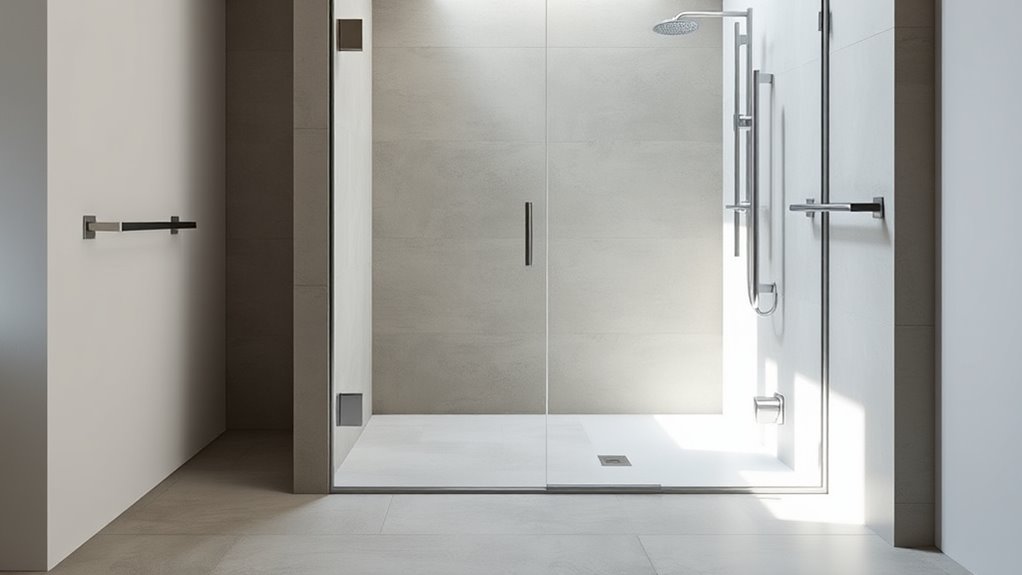
To make your curbless shower accessible for everyone, you need to incorporate features that accommodate diverse mobility needs. Start by choosing custom tile options with textured surfaces, providing slip resistance and safety. Low or zero-threshold entryways are essential, allowing easy access for wheelchairs or walkers. Incorporate grab bars strategically placed for stability, ensuring they blend seamlessly with your design. Use artistic accents, like decorative tiles or mosaic patterns, to add visual interest without sacrificing functionality. Consider wider entry points and non-slip flooring throughout. Additionally, understanding accessibility features can help you select the right modifications to enhance usability and safety for all users. Incorporating safety considerations such as proper drainage and secure fixtures further ensures a secure environment. Being aware of the horsepower of electric dirt bikes can inspire innovative solutions for motorized features in your design, such as motorized door openers or adjustable shower seats. Properly inflated tires are crucial for smooth operation and safety, just as selecting the right inflation techniques ensures optimal performance in your bathroom fixtures. By thoughtfully selecting custom tile choices and integrating artistic accents, you create a space that’s both inclusive and stylish, making your shower welcoming for users of all abilities.
Balancing Aesthetic Appeal With Practical Maintenance Needs
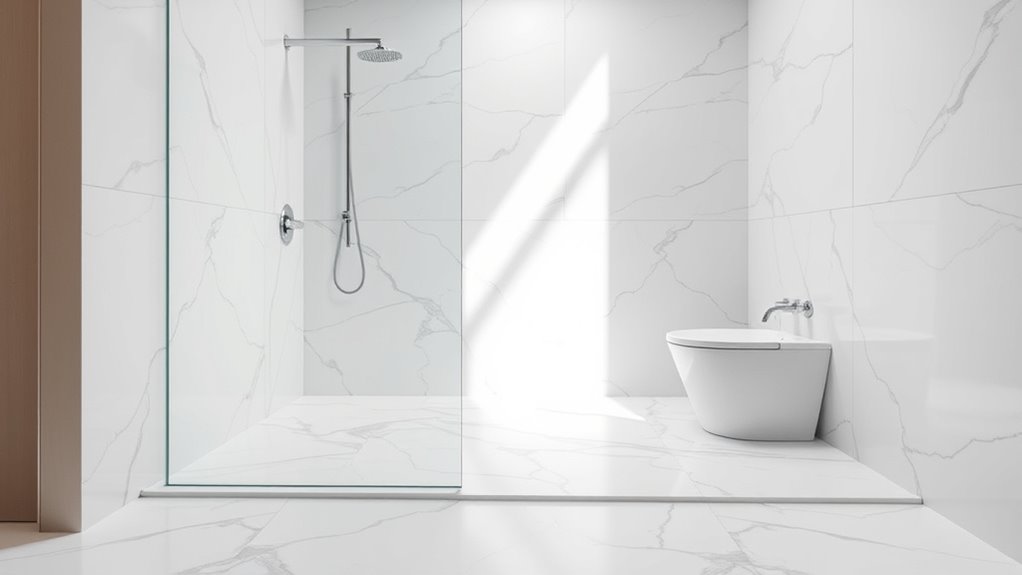
You want your curbless shower to look sleek and seamless, but it also needs to be easy to maintain. Choosing materials that blend well visually can help keep the space feeling open, while smart design choices make cleaning less of a chore. Incorporating energy-efficient fixtures can also reduce water and power consumption, making your bathroom more sustainable. Paying attention to trust issues with boyfriend no-shows can inspire thoughtful planning for reliable use and accessibility in your bathroom design. Finding the right balance guarantees your shower is both beautiful and practical for everyday use.
Seamless Visual Integration
Achieving seamless visual integration in a curbless shower requires careful selection of materials and design elements that blend effortlessly with the surrounding bathroom. You can enhance this by choosing custom tile layouts that create a cohesive look, minimizing visual disruption. Decorative grout choices also play a vital role, allowing you to match or contrast with tiles for subtle or bold effects. To maintain a clean, unified appearance, consider a consistent tile size and color throughout. The table below highlights key considerations:
| Material Choice | Tile Layout Style | Grout Color | Maintenance Impact | Visual Effect |
|---|---|---|---|---|
| Porcelain | Herringbone | Neutral | Easy to clean | Modern, dynamic |
| Glass | Large Format | Clear | Slightly higher | Sleek, open |
| Stone | Linear | Earth tones | Moderate | Natural, warm |
This approach guarantees your shower looks seamless while remaining practical.
Easy Cleaning Solutions
Maintaining a beautiful, seamless curbless shower doesn’t have to mean sacrificing ease of cleaning. When choosing tile, opt for large-format options with minimal grout lines, which reduce dirt buildup and make cleaning simpler. Select tiles with a smooth, non-porous surface that resist mold and soap scum. Your color scheme also plays a role—light, neutral tones can hide water spots and stains, keeping your shower looking fresh longer. Avoid overly textured or busy patterns that trap grime. Instead, focus on sleek, uniform designs that are easier to wipe down. Regularly using gentle cleaning solutions and wiping the surfaces after use will help maintain their appearance. With thoughtful tile selection and strategic color choices, you’ll enjoy a stunning shower that’s also practical to keep spotless.
Working With Professionals: Finding the Right Contractors and Designers
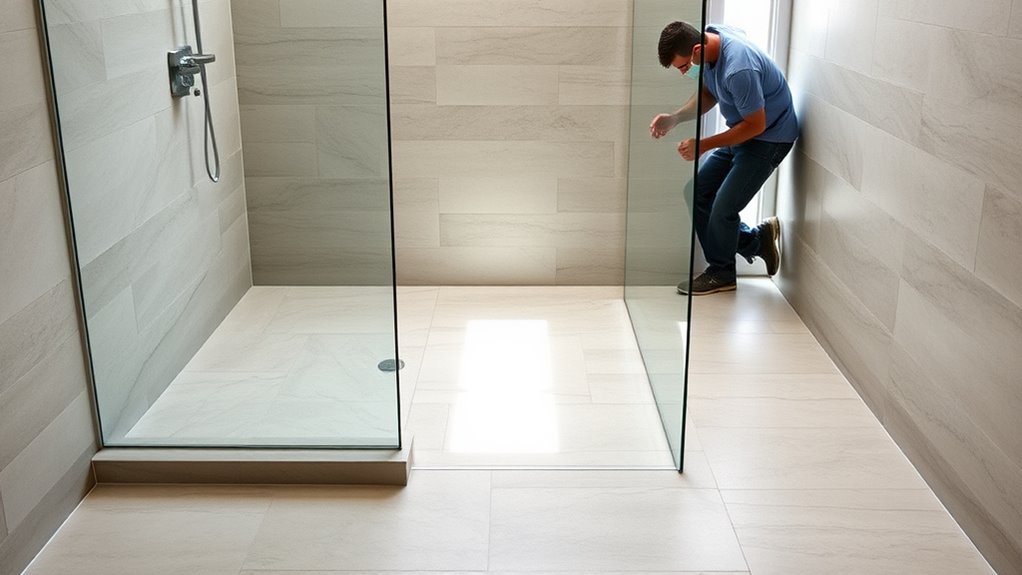
Finding the right contractors and designers is essential to guarantee your curbless shower project turns out exactly as planned. Start by checking their contractor credentials—license, insurance, and experience with curbless showers. This ensures they’re qualified to handle the unique requirements of these installations. During design consultations, communicate your vision clearly and ask for input on materials, layout, and waterproofing. A good designer will help optimize space and style while considering practicality and safety. Don’t hesitate to ask for references or review past projects. The right professionals will listen to your ideas, offer expert advice, and provide a detailed plan. Working with experienced contractors and designers streamlines the process and boosts your confidence that your dream shower becomes a beautiful, durable reality.
Common Pitfalls to Avoid During Installation
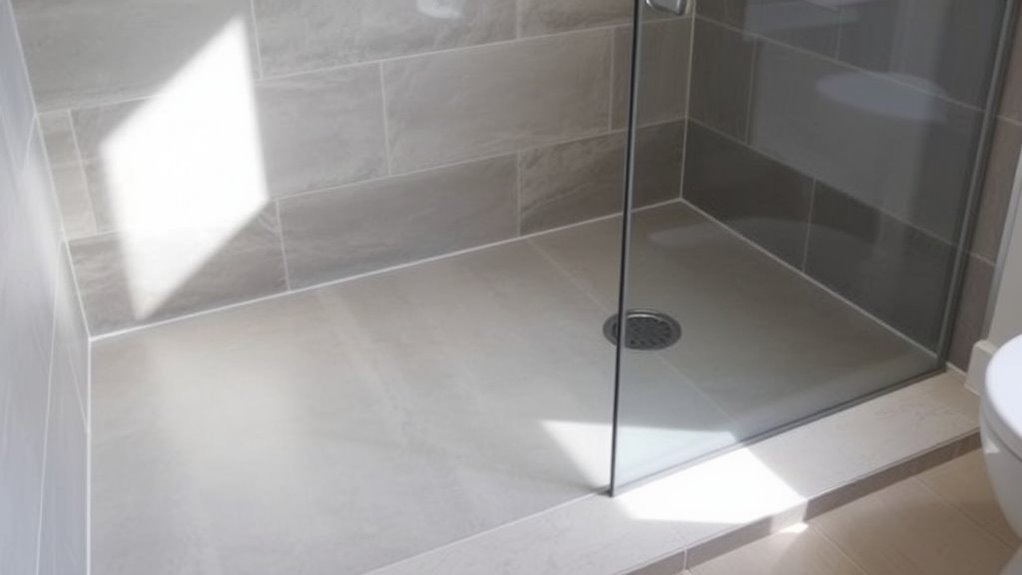
Even with the right professionals on board, certain mistakes can compromise your curbless shower installation. One common pitfall is neglecting proper waterproof membranes; without these, water can seep into surrounding structures, leading to mold and damage. Guarantee waterproof membranes are correctly installed and extended up the walls to prevent leaks. Another mistake is choosing inadequate curb alternatives or failing to properly integrate them into the design, which can cause water escape or uneven flooring. Also, rushing the slope of the shower base can lead to pooling water and slippery surfaces. Avoid shortcuts during waterproofing, and double-check that all components, including drain placement and slope, are correctly executed. Preventing these issues early on ensures your curbless shower remains safe, functional, and visually appealing.
Maintaining Your Curbless Shower for Long-Term Beauty and Performance
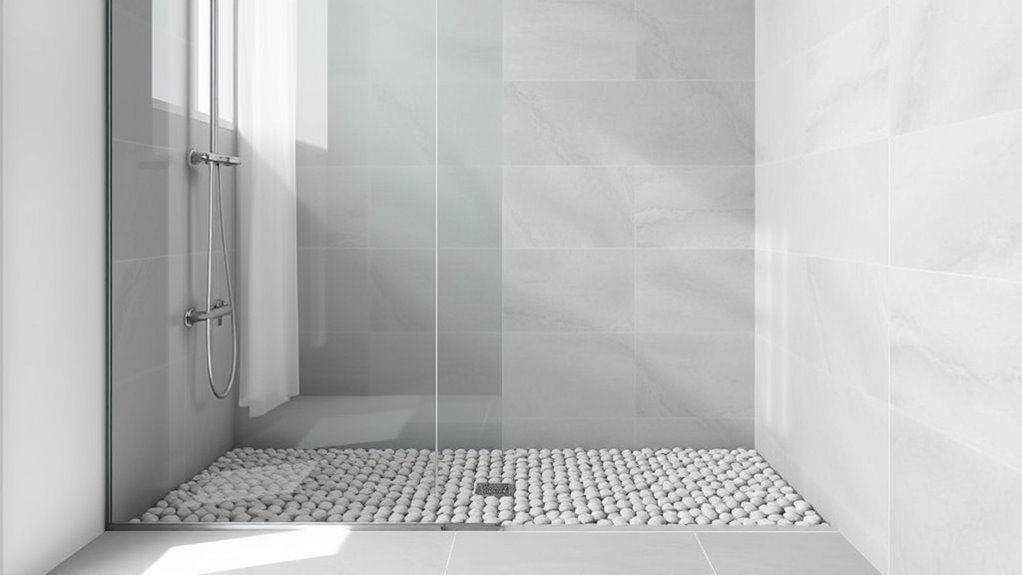
To keep your curbless shower looking stunning and functioning properly over time, regular maintenance is essential. Use eco-friendly materials for cleaning to avoid harsh chemicals that can damage surfaces and harm the environment. Regularly inspect grout lines and seal them as needed to prevent water leaks and mold growth. Enhance lighting with energy-efficient LEDs to highlight your shower’s features and ensure safety. Proper drainage checks help avoid water pooling, which can cause damage or staining. Keep the glass clean with gentle, non-abrasive cleaners to maintain clarity and shine. Incorporating lighting enhancements not only improves aesthetics but also makes maintenance easier. Staying consistent with these practices preserves your shower’s beauty and performance, ensuring it remains a functional, stylish space for years to come.
Frequently Asked Questions
How Do I Prevent Water From Spilling Outside the Shower Area?
To prevent water from spilling outside the shower area, you should use waterproof membranes to line the shower floor and walls, creating a barrier against leaks. Additionally, install high-quality shower seals around doors and entry points to keep water contained. Proper slope of the shower floor is essential, directing water toward the drain. Combining these measures guarantees your shower stays watertight and prevents spills outside the designated area.
What Are the Best Options for Custom-Sized Curbless Showers?
Thinking about a custom-sized curbless shower? You want options that fit perfectly and look sleek, right? Start with custom shower enclosures designed to your exact dimensions—it’s the key to a seamless fit. Pair this with reliable waterproofing solutions to prevent leaks and water damage. With careful planning and quality materials, you’ll create a stunning, functional space that feels tailored just for you.
How Can I Ensure Proper Drainage in a Small Bathroom Space?
To guarantee proper drainage in a small bathroom, you should focus on installing a slight slope toward the drain, avoiding standing water. Use waterproof membranes to prevent leaks and ensure durability. Incorporate slip-resistant tiles to enhance safety, especially in wet areas. Properly positioned drains help water flow efficiently, and regular maintenance keeps everything working smoothly. These steps keep your small bathroom safe, functional, and free from water damage.
Are There Specific Design Styles That Complement Curbless Showers?
Ever wondered what design styles best highlight a curbless shower? You’ll find that modern minimalism emphasizes clean lines, simple fixtures, and a sleek look, perfectly complementing the seamless feel of the shower. Alternatively, rustic charm adds warmth with natural materials and textured finishes, creating a cozy vibe. Both styles enhance the openness and accessibility of a curbless shower, making your bathroom feel more inviting and stylish.
What Maintenance Routines Help Keep the Shower Clean and Functional?
To keep your shower clean and functional, establish a regular cleaning schedule using a gentle, non-abrasive cleaner to prevent soap scum and mold buildup. Wipe down surfaces after each use to reduce water spots. Additionally, check and maintain the sealant periodically to prevent leaks or water damage. Proper sealant maintenance guarantees your shower stays waterproof and looks great, making your routine easier and extending the lifespan of your shower.
Conclusion
A well-designed curbless shower can transform your bathroom into a sleek, accessible space. By choosing the right location, materials, and professional help, you’ll enjoy a safe, low-maintenance, and stylish feature. Remember to prioritize proper drainage, waterproofing, and slip-resistant surfaces. Are you ready to create a seamless, modern shower that combines beauty with practicality? With careful planning, you’ll enjoy your new shower for years to come.

